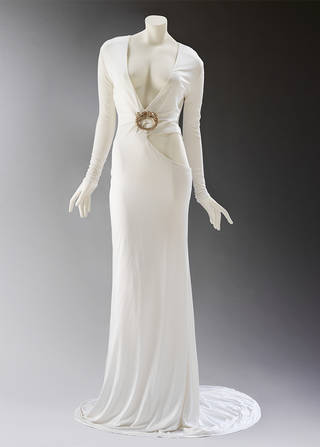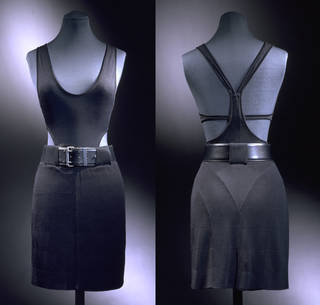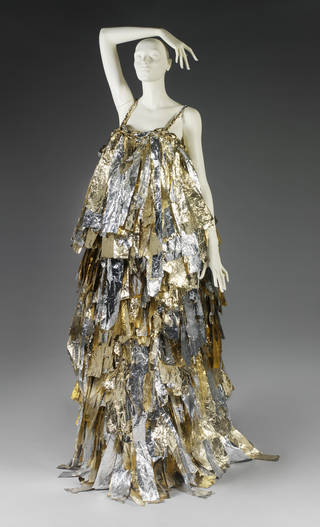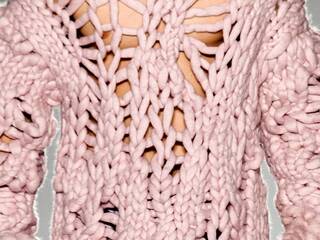The term 'knitwear' conjures up images of cosy knitted jumpers and gloves, however, throughout the 20th century, designers used knitted fabrics to create exquisite and innovative examples of eveningwear. Couture garments such as Madame Grès' Grecian-inspired dresses or Julien Macdonald's intricate knitted lace designs exploit knitwear's potential to provide glamour, rather than warmth.
Knitted eveningwear in the first half of the 20th century
The role of knitted materials in eveningwear is largely thanks to jersey. Silk jersey – knitted with silk rather than wool – is characterised by its softness and stretch, making it particularly suited to creating glamorous designs. Coco Chanel (1883 – 1971) is credited with popularising jersey as part of an everyday wardrobe in the 1920s, although it was later designers who fully explored its eveningwear potential.
The French couturier Madame Grès (1903 – 93) was renowned for her mastery of silk jersey, using it to construct evening dresses with pleats and drapery that recalled the look of classical Grecian dress. A press release from her fashion house described how she, "induced manufacturers to produce jersey in large widths and took part in their researches to apply these techniques". The result was that, although her dresses could use over 20 metres of fabric in their construction, they still maintained a look of lightness and elegance.

The dramatic effects that can be created using jersey are exemplified in a complex 1940s strapless evening dress in our collection, designed by Elsa Schiaparelli (1890 – 1973). The black silk jersey has been gathered from the top to the bottom of the dress, with the ruched fabric creating a spine-like effect down the front. In contrast to Madame Grès' draped styling, Schiaparelli incorporated boning in the bodice to create structure.

The drama and intricacy of the Schiaparelli dress directly contrasts with the simplicity and pared-back form of the wool jersey evening dress designed by Claire McCardell (1905 – 58), just five years later in 1954. McCardell's designs were acclaimed as the 'American Look'. Her womenswear was renowned for its comfort, practicality and simplicity. During the Second World War, when French fashion houses ceased production, McCardell chose to focus on sportswear. These styles exhibited a practicality, with dresses featuring details such as side pockets and adjustable waistbands. Many of her designs were cut on the bias meaning that the fabric was soft and fluid and didn't restrict movement. This focus on both glamour and comfort would be explored further in the 1970s.

Jersey and the 'soft seventies'
It was jersey that was responsible for the so-called 'soft seventies' look, when it was used to create the silhouettes associated with disco glamour in the United States. Roy Frowick Halston (1932 – 90) was particularly renowned for his manipulation of jersey to create sought-after eveningwear and his designs echoed the graceful lines of Madame Grès' gowns. Halston's jersey halter dresses were worn by celebrity clients such as Liza Minnelli and Lauren Bacall.

The potential of silk and viscose jersey was also being explored by British designers. Yuki created a dress with minimal construction made from knitted rayon jersey fabric. The material falls from a single point at the front of the halter neck, relying on the body of the wearer to give it form.

As head designer for Gucci from 1990 to 2004, Tom Ford became known for bringing a commercial sexiness to the Italian label and was particularly renowned for his glamorous eveningwear. A white evening dress with cut-out panels from his final collection for Gucci recalls the designs that had helped catapult him to fame. Made from silk jersey, it is deliberately reminiscent of Halston's designs. "You can take a direct line from me to Halston", Ford told the publication Women's Wear Daily in 2012.

Eveningwear and experimentation
During the 1980s, experiments with elastane fabrics (more widely known under the trade names of Lycra and Spandex) introduced more stretch knit – which became a key look for the decade. Designer Azzedine Alaïa, nicknamed 'The King of Cling', was renowned for his 'body conscious' fashion which was characterised by figure-hugging jersey creations featuring cutaway areas designed to reveal more flesh.

British designer Julien Macdonald created an intricately knitted evening dress intended to be worn only with a pair of black pants. Inspired by both V-neck t-shirts and 1930s bias-cut evening dresses, this design was constructed from machine-knitted and hand-knitted viscose and lurex, and took Macdonald three weeks to make.

Craig Lawrence, who graduated from London's Central Saint Martins college in 2009, became known for his innovative work in knitwear. Known for creating high fashion from everyday materials such as sweet wrappers and bin bags, his opulent shimmering evening dress in our collection is constructed from foil tape strips that have been knitted into the design.

Far removed from the traditional style of knitting for warmth and practicality, the knitted eveningwear in our collection reveals how materials such as jersey have been exploited to create intricate, flowing and elegant designs by some of the 20th centuries best known fashion designers.


